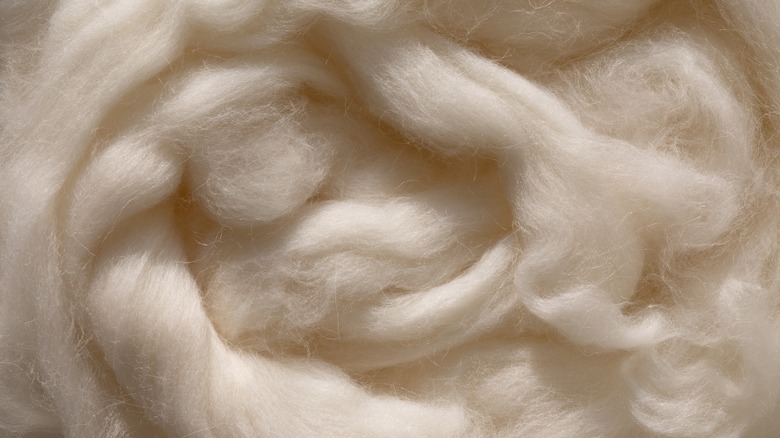Could Wool Be The Dreamiest Type Of Pillow On The Market?
Getting a good night's sleep is an integral part of living a good life, and having the right sleeping arrangement plays a significant role in your snoozing success. There are many factors that contribute to a proper sleeping environment, including good air quality, a clean home, a comfortable mattress, and the best pillow. It is undeniable that there are countless types of pillows on the market, each promising its own set of unique benefits, but one unexpected class of pillows could rival even the fanciest of options: wool pillows.
Wool pillows are a niche product that very much fly under the radar, though proponents of natural living may be familiar with their long history. There is evidence suggesting that wool was in use as a clothing textile over 3,000 years ago and possibly much longer — though it is less common to find 100% wool products today, following the advent of cheaper, synthetic materials. Humble though their composition may be (they are made by simply filling a pillow with balls of wool down that has been sheared from sheep) wool pillows boast impressive performance and lifespans compared to conventional pillows that you should replace often and in regular intervals.
Benefits you'll love
Given the role that it has to play for sheep (keeping them warm and dry in environments that can be either hot or cold and often very wet), wool has countless benefits as a textile. It is highly breathable and possesses antimicrobial properties, in addition to being incredibly durable when properly cared for. Wool pillows are a superb option for individuals who suffer from allergies, thanks to the textile's breathability and antimicrobial nature, making them an inhospitable environment for bacteria, moisture, and dust mites, which happily prey on synthetic or lower-quality fibers found in conventional pillows.
Speaking of synthetic fibers, wool is also a climate-friendly alternative that uses 18% less energy than polyester and 70% less water than cotton. Another benefit of wool pillows is the fact that they are free from the addition of synthetic chemicals; many conventional pillows are manufactured to be fire resistant, whereas wool has naturally fire-retardant properties, in addition to being difficult to ignite when compared to other synthetic textiles. Wool pillows can also help naturally regulate your body temperature if you struggle to stay cool or find your current pillow traps heat from your head. Lastly, wool pillows are beyond easy to care for. Instead of refreshing your pillow in the washing machine — which cannot be done for certain pillow types — dump the wool filling from the case onto a sheet outside, during a bright and sunny day. The sunlight will freshen the wool fibers, in addition to whitening them.
Drawbacks to consider
While there is an immense amount to love about wool pillows, several drawbacks exist. Firstly, individuals who are highly sensitive to smell may find the original odor of wool pillows to be rather off-putting (it is important to note that the odors are completely natural and harmless). The odors will dissipate over time, but may smell more strongly during the initial months of usage. You can also place the pillow out in the sun (as you would to naturally brighten your whites without bleach) to help speed up the deodorization process.
The second consideration is the price of wool pillows. Since they are made from natural fibers that are generally sourced from high-quality wool producers, you can expect to pay significantly more for a wool pillow than you would for a mainstream pillow. Adding to the higher price point of wool pillows is the fact that they are a more obscure product with less market demand. You can expect to pay anywhere from $60 to $130 for a wool pillow, depending on the brand and certifications you are interested in (such as a 100% organic pillowcase or a specialty design). Despite the high price, however, wool pillows can still be a smart investment to make; they can last for decades with proper care, essentially paying for themselves if you had formerly been cycling through synthetic or cotton pillows every few years.


